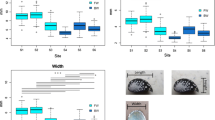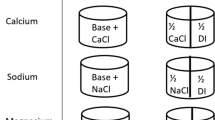Abstract
In this study, we examine salinity stress tolerances of two populations of the invasive species New Zealand mud snail Potamopyrgus antipodarum, one population from a high salinity environment in the Columbia River estuary and the other from a fresh water lake. In 1996, New Zealand mud snails were discovered in the tidal reaches of the Columbia River estuary that is routinely exposed to salinity at near full seawater concentrations. In contrast, in their native habitat and throughout its spread in the western US, New Zealand mud snails are found only in fresh water ecosystems. Our aim was to determine whether the Columbia River snails have become salt water adapted. Using a modification of the standard amphipod sediment toxicity test, salinity tolerance was tested using a range of concentrations up to undiluted seawater, and the snails were sampled for mortality at daily time points. Our results show that the Columbia River snails were more tolerant of acute salinity stress with the LC50 values averaging 38 and 22 Practical Salinity Units for the Columbia River and freshwater snails, respectively. DNA sequence analysis and morphological comparisons of individuals representing each population indicate that they were all P. antipodarum. These results suggest that this species is salt water adaptable and in addition, this investigation helps elucidate the potential of this aquatic invasive organism to adapt to adverse environmental conditions.




Similar content being viewed by others
References
Alonso A, Camargo JA (2003) Short-term toxicity of ammonia, nitrite and nitrate to the aquatic snail Potamopyrgus antipodarum (Hidrobiidae, Mollusca). Bull Environ Contam Toxicol 70:1006–1012
Alonso A, Castro-Diéz P (2008) What explains the invading success of the aquatic Mud snail Potamopyrgus anitpodarum (Hydrobiidae, Mollusca)? Hydrobiologia 614:107–116
Altschul SF, Madden TL, Schaeffer AA, Zhang J, Zhang Z, Miller W, Lipman DJ (1997) Gapped BLAST and PSI-BLAST: a new generation of protein database search programs. Nucleic Acids Res 25:3389–3402
ANS (2007) National management and control plan for the New Zealand mudsnail (Potamopyrgus antipodarum). United States Federal Aquatic Nuisance species Task Force. http://www.anstaskforce.gov/Documents/NZMS_MgmtControl_Final.pdf. Accessed 7 Sept 2010
Ausubel F, Brent R, Kingston R, Moore D, Seidman J, Smith J, Struhl K (2002) Short protocols in molecular biology: a compendium of methods from current protocols in molecular biology, 3rd edn. Wiley, New York
Bersine K, Brenneis V, Draheim R, Rub A, Zamon J, Litton R, Hinton S, Sytsma M, Cordell J, Chapman J (2008) Distribution of the invasive New Zealand mudsnail (Potamophygus antipordarum) in the Columbia River Estuary and it’s first recorded occurrence in the diet of juvenile Chinook salmon (Oncorhynchus tshawystscha). Biol Invasions 10:1381–1388
Berson A (2010) New Zealand mudsnail sightings distribution. newzealandmudsnaildistribution.aspx Accessed 7 Sept 2010
Bowler P (1992) The rapid spread of the freshwater Hydrobiid snail Potamopyrgus antipodarum (Gray) in the Middle Snake River, Southern Idaho. Proc Desert Fish Coun 21:173–182
Brenneis VEF, Sih A, de Rivera CE (2011) Integration of an invasive consumer into an estuarine food web: direct and indirect effects of the New Zealand mud snail. Oecologia 167:169–179
Costil K, Dussart GBJ, Daguzan J (2001) Biodiversity of aquatic gastropods in the Mont St-Michel basin (France) in relation to salinity and drying habitats. Biodivers Conserv 10:1–18
Davidson T, Brenneis E, De Rivera C, Draheim R, Gillespie G (2008) Northern range expansion and coastal occurrences of the New Zealand mud snail, Potamophyrgus antipodaum (Grey, 1843) in the northeast Pacific. Aquat Invas 3:349–353
Duft M, Shulte-Oehlmann U, Tillman M, Markert B, Oehlmann J (2003) Toxicity of triphenyltin and tributyltin to the freshwater mudsnail Potamopyrgus antipodarum in a new sediment biotest. Environ Toxicol Chem 22:145–152
Duncan A, Klekowski PKS (1967) The influence of salinity of the survival, respiratory rate and heart beat of young Potamopyrgus jenkinsi (Smith) Prosobranchia. Comp Biochem Physiol 22:495–505
Dybdahl MF, Drown DM (2011) The absence of genotypic diversity in a successful parthenogenic invader. Biol Invasions 13:1663–1672
Dybdahl MF, Kane SL (2005) Adaptation versus phenotypic plasticity in the success of a clonal invader. Ecology 86:1592–1601
Emmett R, Llansó R, Newton J, Thom R, Hornberger M, Morgan C, Levings C, Copping A, Fishman P (2000) Geographic signatures of North American west coast estuaries. Estuaries 23:765–792
Gangloff M (1998) The New Zealand mud snail in Western North America. Aquat Nuisance Spec Dig 2:25–30
Haag CR, Ebert D (2004) A new hypothesis to explain geographic parthenogenesis. Ann Zool Fennici 41:539–544
Hylleberg J, Siegismund HR (1987) Niche overlap in mud snail (Hydrobiidae): freezing tolerance. Mar Biol 94:403–407
Jacobsen R, Forbes V (1997) Clonal variation in life-history traits and feeding rates in the gastropod, Potamopyrgus antipodarum: performance across a salinity gradient. Funct Ecol 11:260–267
Jacobsen R, Forbes V, Skovgaard O (1996) Genetic populations structure of the prosobranch snail Potomopyrgus antipodarum (Gray) in Denmark using PCR-RAPD fingerprints. Proc R Soc Lond B 263:1065–1070
Kerans BL, Dybdahl MF, Gangloff MM, Jannot JE (2005) Potamopyrgus antipodarum: distribution, density, and effects on native macroinvertibrate assemblages in the greater Yellowstone ecosystem. J N Am Benthol Soc 24:123–138
Lee II H, Brown C (2009) Classification of regional patterns of environmental drivers and benthic habitats in Pacific Northwest Estuaries. United States Environmental Protection Agency, Office of Research and Development, National Health and Environmental Effects Research Laboratory, Western Ecology Division, Newport, OR. EPA/600/R-09/140, p 296
Lee CE, Peterson CH (2003) Effects of developmental acclimation on adult salinity tolerance in the freshwater-invading copepod Eurytemora affinis. Physiol Biochem Zool 76:296–301
Litvaitis M, Nunn G, Thomas W, Kocher T (1994) A molecular approach for the identification of meiofaunal tuberellarians (Platyhelminthes, Turbellaria). Mar Bio 120:437–442
Lively CM (1992) Parthenogenesis in a freshwater snail reproductive assurance versus parasitic release. Evolution 46:907–913
Lynch M (1984) Destabilizing hybridization, general purpose genotypes and geographic parthenogenesis. Q Rev Biol 59:257–290
Marshal JW, Winterbourn MJ (1979) An ecological study of a small New Zealand stream with particular reference to the oligochaeta. Hydrobiologia 65:199–208
Miranda NAF, Perissinotto R, Appleton CC (2010) Salinity and temperature tolerance of the invasive freshwater gastropod Tarebia granifera. S Afr J Sci 106:1–7
Møller V, Forbes VE, Depledge MH (1994) Influence of acclimation and exposure temperature on the acute toxicity of cadmium to the freshwater snail Potamopyrgus antipodarum (Hydrobiidae). Environ Toxicol Chem 13:1519–1524
Nieman M, Paczesniak D, Soper DM, Baldwin AT, Hehman G (2011) Wide variation in ploidy level and genome size in a New Zealand freshwater snail with coexisting sexual and asexual lineages. Evolution 11:3202–3216
Palumbi SR, Martin AP, Romano SL, McMillan WO, Stice L, Grabowski G (1991) The simple fool’s guide to PCR. Dept. of Zoology, University of Hawaii, Honolulu
Richards DC (2002) The New Zealand mudsnail invades the Western United States. Aquat Nuisance Spec Dig 4:42–44
Stoddard J (2006) Environmental monitoring and assessment program (EMAP): Western Streams and Rivers Statistical Summary. US Environmental Protection Agency, Washington, DC, EPA/620/R-05/006, p 1762 (http://www.epa.gov/wed/pages/publications/authored/EPA620R-05006EMAPWStatisticalSummaryForDistribution.pdf). Accessed 7 Sept 2010
Swartz R, Deben W, Jones J, Lamberson J, Cole F (1984) Phoxocephali amphipod bioassay for marine sediment toxicity. ASTM Special Tech Pub 854:284–306
Vinson MR, Baker MA (2008) Poor growth of Rainbow Trout fed New Zealand Mud Snails Potamopyrgus antipodarum. N Am J Fish Manage 28:701–709
Weatherhead MA, James MR (2001) Distribution of macroinvertebrates in relation to physical and biological variables in the littoral zone of nine New Zealand lakes. Hydrobiologia 462:115–129
Winterbourn M (1970) The New Zealand species of Potamopyrgus (Gastropoda:Hydrobiidae). Malacologia 10:283–321
Wolff W (2000) Rcent human-induced invasions of fresh waters by saltwater animals? Aquat Ecol 34:319–321
Zaranko D, Farara D, Thompson F (1997) Another exotic mollusc in the Laurentian Great Lakes: the New Zealand native Potomopyrgus antipodarum (Gray 1843) (Gastropoda, Hydrobiidae). Can J Fish Aquat Sci 54:809–814
Acknowledgments
This work was supported by the US Geological Survey. The use of trade, firm, or corporation names in this publication is for the information and convenience of the reader. Such use does not constitute an official endorsement or approval by the US Department of Interior or the US Geological Survey of any product or service to the exclusion of others that may be suitable.
Author information
Authors and Affiliations
Corresponding author
Additional information
Handling Editor: Piet Spaak.
Rights and permissions
About this article
Cite this article
Hoy, M., Boese, B.L., Taylor, L. et al. Salinity adaptation of the invasive New Zealand mud snail (Potamopyrgus antipodarum) in the Columbia River estuary (Pacific Northwest, USA): physiological and molecular studies. Aquat Ecol 46, 249–260 (2012). https://doi.org/10.1007/s10452-012-9396-x
Received:
Accepted:
Published:
Issue Date:
DOI: https://doi.org/10.1007/s10452-012-9396-x




